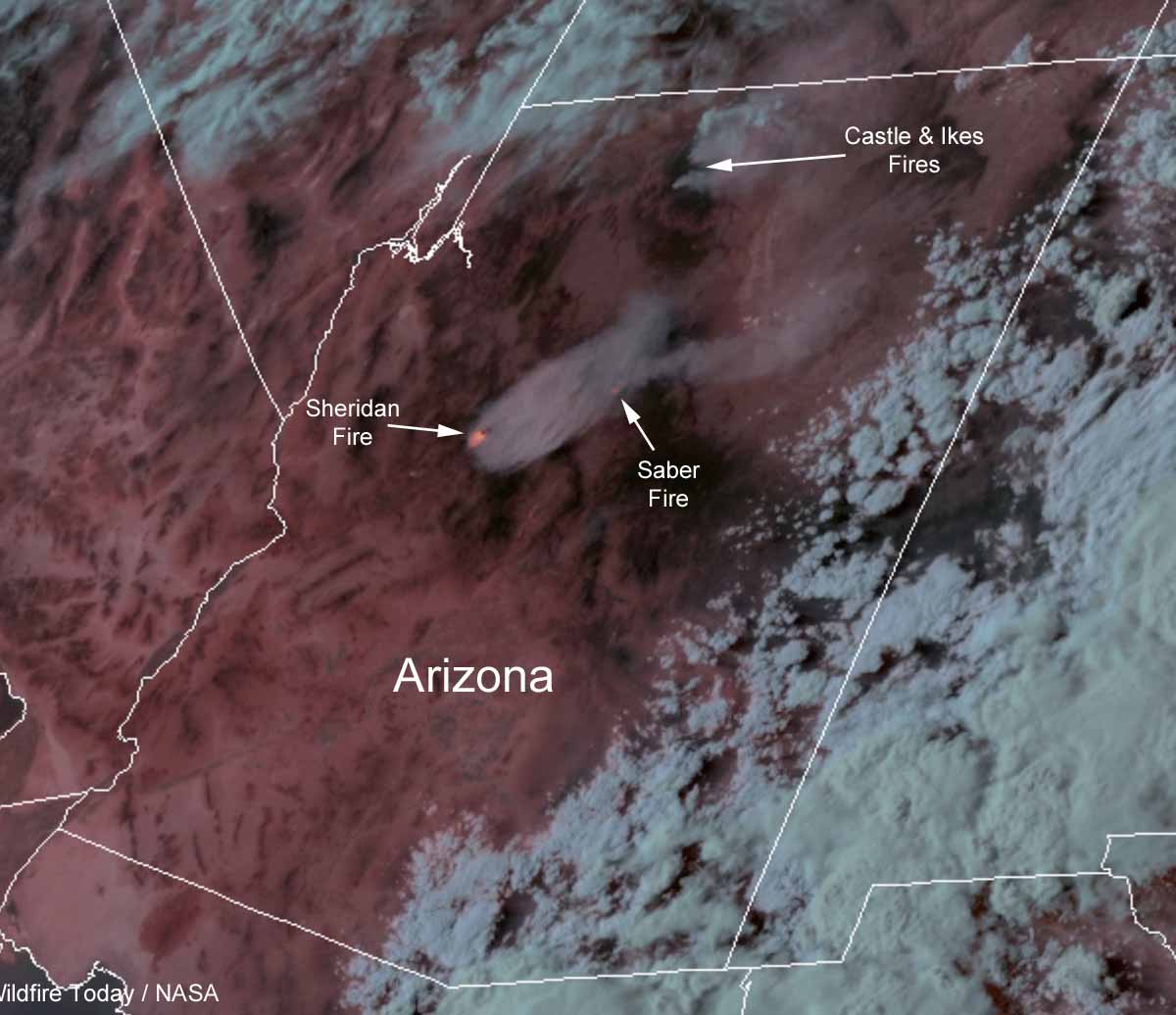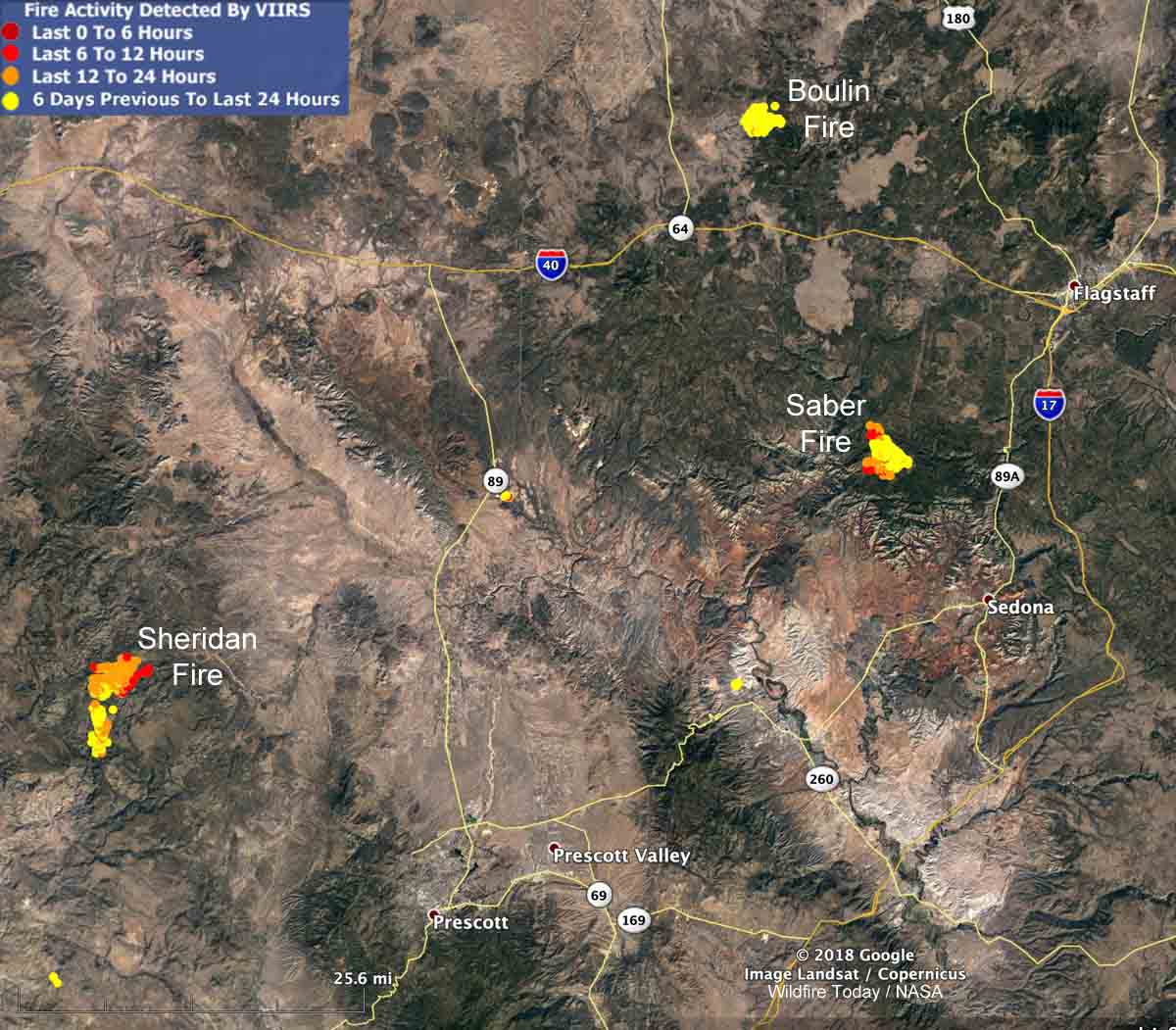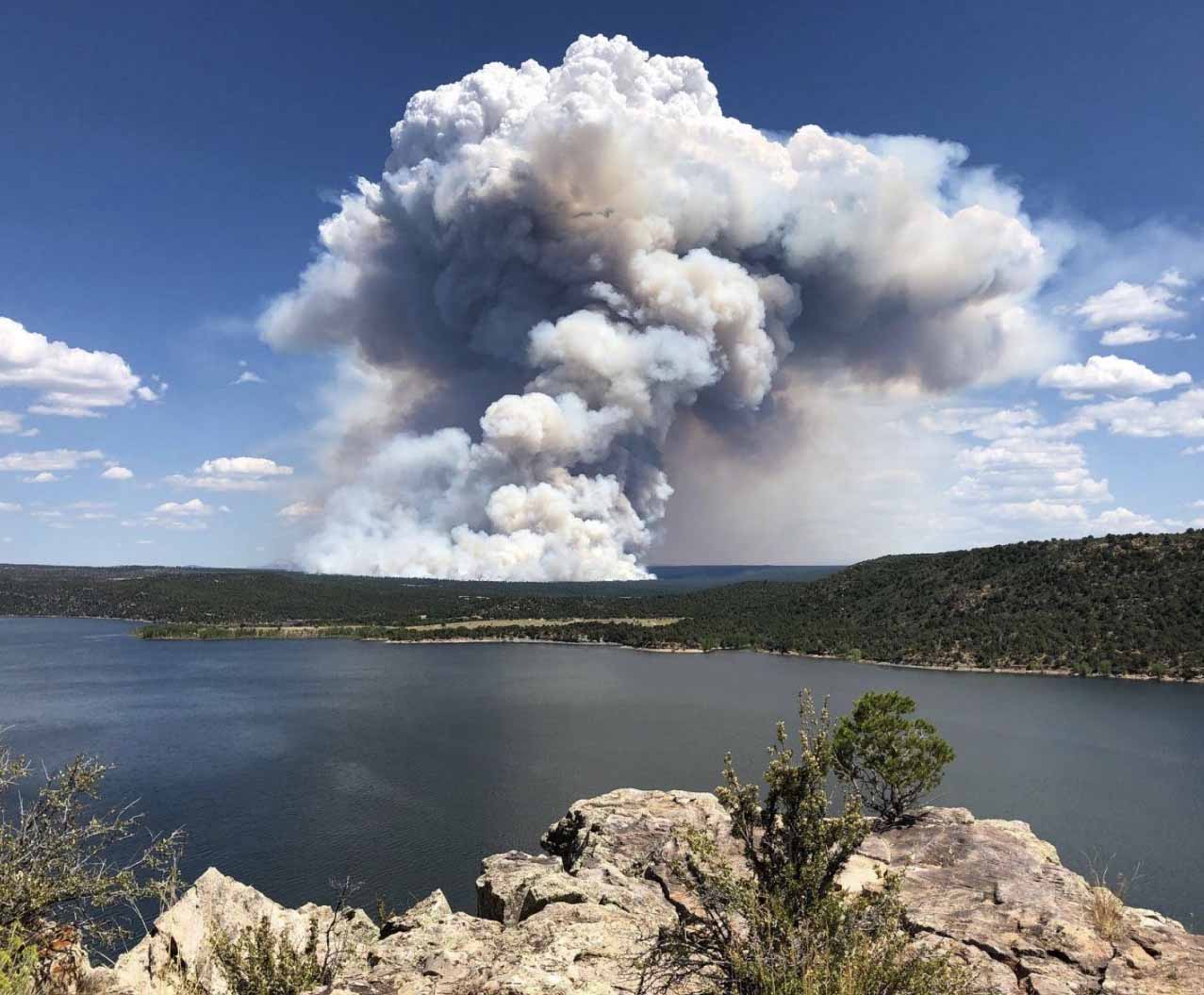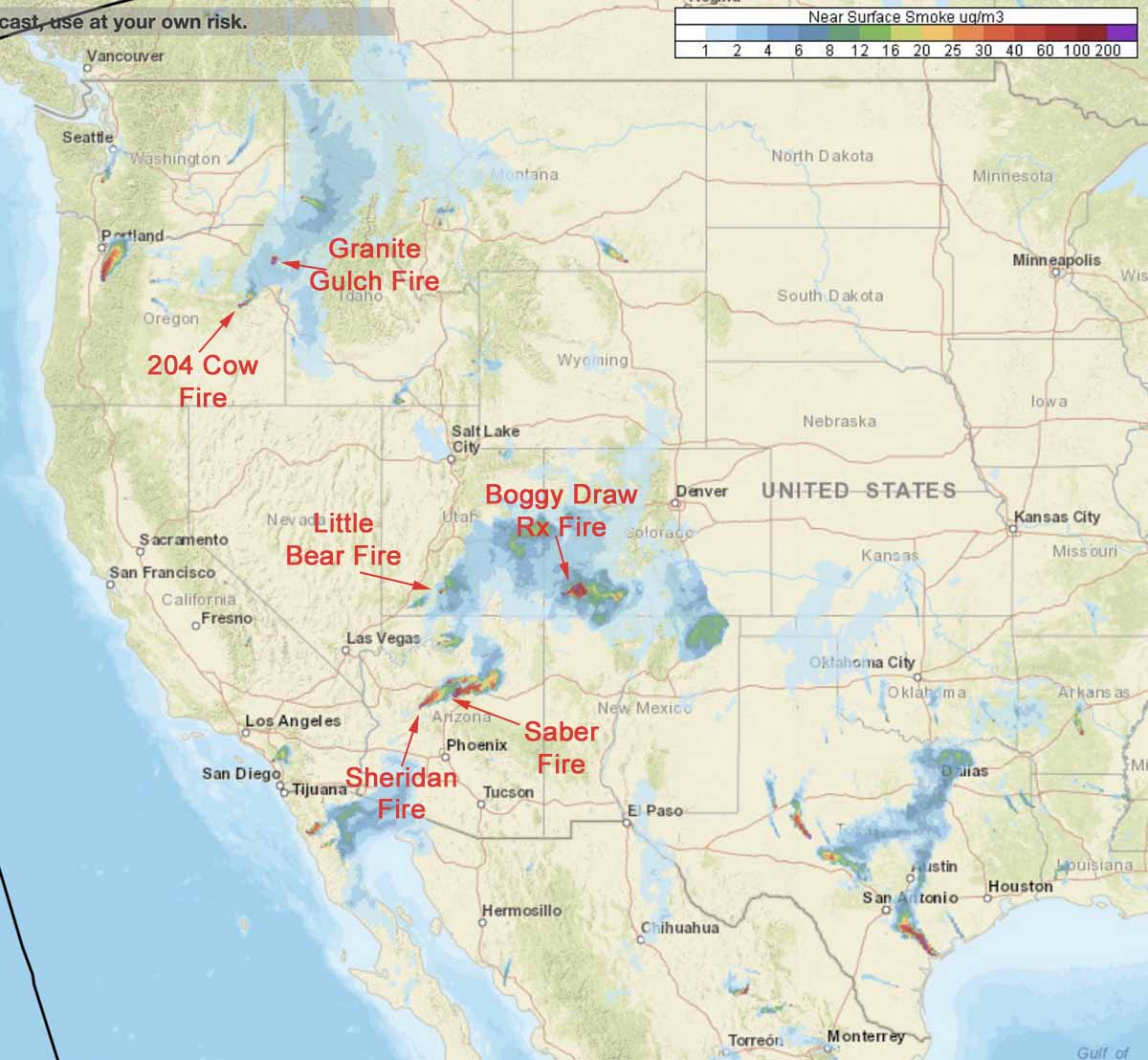
Smoke from wildfires in Arizona is spreading east into New Mexico, Texas, Colorado, Oklahoma, and Kansas.
News and opinion about wildland fire
Sheridan, Boulin, and Saber fires, all within 70 miles of Flagstaff

Three wildfires in Central Arizona have burned a total of more than 14,000 acres. All of the fires are being managed, rather than suppressed, in order to enhance the natural resources.
The Sheridan Fire 26 miles northwest of Prescott is by far the most active of the three, more than tripling in size over the last two days. (See map below) The fire behavior is described as extreme, with running, wind-driven runs, and short-range spotting. A mapping flight early Thursday morning found that the lightning-caused fire had burned 8,594 acres. About 75 percent of the fire is being monitored while 25 percent is under a point protection strategy, suppressing or retarding the spread in order to protect specific sites.
The Saber fire, also started by lightning, has burned 2,093 acres 16 miles southwest of Flagstaff. Very little current information is available about this incident.
The 3,900-acre Boulin Fire 24 miles northwest of Flagstaff has calmed down considerably after putting up a large column of smoke on August 20.

States affected include Washington, Idaho, Utah, Colorado, New Mexico, Arizona, Alaska, and Texas

While currently there are not a great many active wildfires in the lower 48 states, the ones that are burning are creating a surprising amount of smoke.
Smoke from wildfires in Texas is expected to move into the Austin, Dallas, and Fort Worth areas Wednesday afternoon.

Ignition on the Boggy Draw prescribed fire in the San Juan National Forest north of Dolores, Colorado is complete, but the fire is still producing smoke. The Colorado Department of Public Health and Environment issued a statement Wednesday, saying, “Light-to-moderate impacts are expected in the immediate vicinity of the fire. No public health concerns are anticipated at this time.”
We don’t have a smoke map for Alaska but smoke from local fires is expected to plague residents of Anchorage until this weekend.
As used in the Northern Rockies
(Above: screenshot from the video below)
The Northern Rockies Coordinating Group worked with the Montana Logging Association to create this video to educate fire managers about the concept and configuration of Heavy Equipment Task Forces used on timber fires in the Northern Rockies Geographic Area.
The task forces can be configured with the following pieces of equipment:
The first 8 minutes and 15 seconds covers how the task forces are organized and fit into the incident management organization. The rest goes into detail about the capabilities of each category of equipment.
The anonymous producer, director, editor, and videographer obviously put a great deal of work into creating this video, using dozens and dozens of clips that clearly illustrate everything mentioned in the narrative. They should get the credit they deserve.
(If the embedded video does not appear above it may be because the Northern Rockies Geographic Area file was moved. If that happens and you know the new location, let us know.)
Thanks and a tip of the hat go out to Eric. Typos or errors, report them HERE.
Above: screenshot from the video below.
Big Cypress has released their second in a series of three films about prescribed fire in the south Florida Park, titled, Burn Boss: A History of Fire and People in Big Cypress.
Here is their description:
The job of the Burn Boss is difficult. Perhaps the toughest in all of professional conservation. To be the Boss of Fire, you must be willing to take responsibility for one of nature’s most powerful forces: Fire.
Jennifer Brown and Into Nature Films worked shoulder-to-shoulder with Big Cypress National Preserve to tell the history of the National Park Service’s most accomplished fire program. With beautiful cinematography, fascinating interviews, and tantalizing story, this film highlights the colorful people and places in the wild heart of south Florida, narrated and written by Rick Anderson, a descendent of Florida pioneers. Rick has dedicated his life to the use of fire for the land.
Last month the first film in the series was released, “Fire Swamp”, that explains the relationship between fire and the swamp.

Smoke from hundreds of fires in the Amazon Basin combined with clouds Monday afternoon to plunge a major South American city into darkness.
Numerous fires in Bolivia and the Amazon Basin in Brazil have been creating smoke in recent days that got pushed hundreds of miles by a cold front to Sao Paulo, turning the sky dark.
Below is an excerpt from an article in the Washington Post:
“The smoke [Monday] didn’t come from fires in the state of Sao Paulo, but from very dense and wide fires that have been happening for several days in [the state of] Rondonia and Bolivia,” Josélia Pegorim, a meteorologist with Climatempo, said in an interview with Globo. “The cold front changed direction and its winds transported the smoke to Sao Paulo.”
The news highlighted the number of forest fires in Brazil, which rose by more than 80 percent this year, according to data released this week by the National Institute for Space Research (INPE).
“This central Brazil and south of the Amazon Rainforest region has been undergoing a prolonged drought,” Alberto Setzer, a researcher at INPE, said in an interview with local media outlets. “And there are some places where there has not fallen a drop of rain for three months.”
Most of the Amazon was once considered fireproof, but as climate change and deforestation remake the world, wildfires are increasing in frequency and intensity, recent research has shown.
In the Amazon region, according to NASA, fires are rare for much of the year because wet weather prevents them from starting and spreading. However, in July and August, activity typically increases due to the arrival of the dry season. Many people use fire to maintain farmland and pastures or to clear land for other purposes. Typically, activity peaks in early September and mostly stops by November.
The map above, showing heat and smoke in Brazil and Bolivia on August 14, is the best we could find. More recent satellite imagery has either clouds, or smoke so dense over very large areas that smoke from individual fires couldn’t be distinguished from smoke covering very large areas.